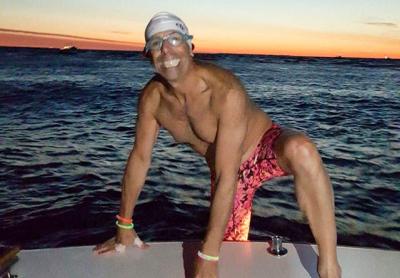Spencer Schneider’s ‘Valiant’ Try Across Block Island Sound

George Velmachos, an experienced fisherman, was gazing from Montauk Point out toward Block Island one day in late August, wondering why no one had yet attempted to swim that span (14 miles as the crow flies).
Two days later, he was told by his friend Dennis Loebs that, on Sept. 2, Spencer Schneider, a 57-year-old long-distance swimmer and corporate attorney who lives in Northwest Woods, would try, and was asked if he’d like to come along.
“It’s the local Everest of swimming,” Sinead FitzGibbon, Loebs’s wife and a strong endurance athlete herself (in addition to being a physical therapist with a Ph.D.), said during a telephone conversation Monday.
“It’s not just about endurance, training, strength, or conditioning — it’s about logistics,” she explained.
Schneider’s team also included Bonnie Schwartz, a well-known coach of open water swimmers who has swum the English Channel. It was she, said FitzGibbon, who timed his electrolyte and carbohydrate feedings, kept track of his stroke rate, and, through periodic questioning, kept track of the state of his mind.
As it turned out, primarily because Block Island Sound was several degrees colder than usual for the time of year, Schneider abandoned the attempt about four and a half hours into it, somewhat more than halfway to his goal.
“He was disappointed initially, but just for a moment, which tells you a lot about him,” FitzGibbon reported. “In a matter of minutes, we were talking about a new plan for next year. And I have no doubt he’ll do it. You know, people think long-distance swimmers are super tough. Spencer’s got a different kind of toughness, an emotional resilience, a mental flexibility that enables him to adapt. It’s easy to be happy when everything’s going well. In defeat you see what people are made of.”
Two years ago at this time Schneider swam 17.3 miles from Ditch Plain, Montauk, to Amagansett’s Lazy Point, on the bayside — a swim that was authenticated by the Marathon Swimmers Federation.
“But swimming in the ocean is a lot different than swimming in the bay,” said Schneider. “I was expecting 71 or 72 degrees rather than 67 or 68. I was shivering, I felt as if I could have swum more . . . it was the cold more than anything, I wasn’t exhausted.”
“If the water had been three or four degrees warmer, he could have stayed in — he could have done it in nine hours, maybe eight if there’d been less of a chop,” said FitzGibbon, who, in a 20-foot oceangoing shell rowed along beside him, about 10 yards off, as Loebs piloted his former Maine lobster boat, Sandy, with Schwartz, Velmachos, and Kenneth Bernstein, the official observer, aboard.
FitzGibbon herself has made the crossing a number of times, with Paddlers 4 Humanity, in a shell and on a stand-up paddleboard. “It’s 14 miles as the crow flies, though we [Dan Farnham, a commercial fisherman and top-level mountain-biker, had plotted the route] were projecting 18 to 19.”
“Dennis brought the boat over from Sag Harbor. We met at a Lake Montauk marina at about 4:40 a.m. and went over to Turtle Cove from there. Spencer set off at about 5:30. It was choppy. The swells were out of the southwest, but the wind was north, off his shoulder. The waves and the wind were against each other. It was challenging. I rowed so I could always keep him in sight, and yet there were times, because of the chop, when he would disappear.”
Were a swimmer’s stroke rate to drop by five-plus per minute, say, his coach would know fatigue was setting in, said FitzGibbon, “but that didn’t happen in Spencer’s case. His strength wasn’t waning, he was mentally competent, but the cold numbs you. . . . A couple of degrees when you’re immersed can make a big difference. Brown fat helps your body retain heat, but in cold conditions it can burn rapidly and that can be critical metabolically over a five-hour span.”
While he had trained seriously for the crossing attempt, Schneider, who is a member of the East Hampton Village Ocean Rescue Squad and has also swum around Manhattan and has done three stages of the 120-mile 8 Bridges swim in the Hudson, said he would obviously have benefited from cold water training.
“I did the Ditch Plain to Lazy Point swim in 10 hours, but the water temperature was 72 degrees.”
Adding to the difficulty, FitzGibbon said, was the fact that the changing tide “would have swept him south of Block Island had we kept going. This swim is very technical. You’re pushed north initially by the incoming tide and, later, you’re pushed south by the outgoing tide. But the real killer was that the ocean was colder. Next year, Spencer may try it from mid to late August.”
“Absolutely, my hat’s off to him,” she said in answer to a question. “It was a valiant try. Once he does this, it will open the floodgates.”
Schneider said, “We’ll probably have to start earlier in the day next year so that we can time the tides better. . . . I learned a lot. It was uncharted water really when it comes to swimming. It’s trial and error. There was no history, as there is with the English Channel and the Catalina crossing.”
“Nobody lost heart,” Schneider added. “It will be more exciting next year. I could have swum more, but I was really, really cold. I said that was it. They said, ‘You’re almost there, just a few more hours.’ ”
“ ‘No, no,’ I said. I got no argument. . . . This was my first attempt. I won’t surrender next time.”
